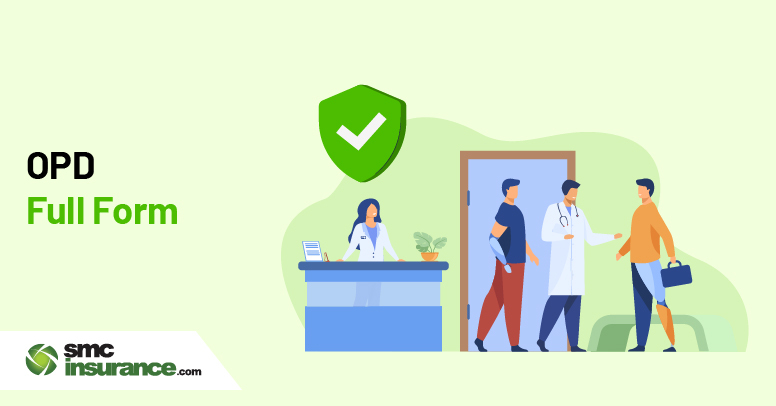It was a usual Monday morning. As Ravi was on his way to the office, he noticed something. The city was alive, tea stands were crowded, and hospitals? Already overcrowded. People were coming and going; some were waiting, while others were carrying reports. No stretchers, no hospital beds. Just people going in for a checkup or a second opinion. Reality hit and he thought that it is the heartbeat of our healthcare system in action. And at the heart of it all is something we hear a lot but hardly ever think about: OPD.
What actually takes place in an OPD? Does it treat more than just coughs and fevers? Is it possible to conduct tests there? And is it covered by your health insurance?
In the article that follows, we'll go over what OPD actually is, how it works, and why it matters.
What is the Full Form of OPD in Medical?
The full name, Outpatient Department, stands for a simple but important idea in healthcare: treatment without admission. OPD is the term used in hospital and medical insurance terminology to describe services offered to patients who arrive for consultation, testing, or minor care and return the same day.
What is OPD in a Hospital?
Just picture yourself walking into a hospital, registering, waiting for a while, consulting the doctor, possibly getting a test done, grabbing prescription medications, and then leaving before it is even time for bed. That's how OPD works. Most outpatient departments (OPDs) are on the ground floor and have places for consultations, labs, pharmacies, and sometimes even a physiotherapy unit or a centre for immunisations.
It is typically the first point of contact for most patients. Everything is taken care of here without requiring you to be admitted, including minor stitches, dermatology advice, chest X-rays, and general examinations.
OPD Key Services and Features
Let’s be honest, the OPD is where most of us actually begin (and end) our medical needs. You feel unwell, you visit the OPD. Simple. So, what happens there?
- Consultation with Specialists
You don’t always need to go through the hassle of admission just to see a doctor. At the OPD, you can meet general physicians or specialists, be it a cardiologist for chest discomfort, an orthopedist for joint issues, or even a skin doctor for that annoying rash that won’t leave. Everything’s scheduled, smooth, and usually wrapped up in one visit.
- Diagnostic Tests
Need a blood test? X-ray? Maybe an ultrasound? Most hospitals have the testing labs either inside the OPD or just a short walk away. Saves you time and a second trip.
- Minor Procedures
Not all treatments need a hospital bed. Needs like dressing wounds, injections, stitches, or other small procedures are done right there in the OPD. No admission, no hospital gown, no overnight stay.
- Vaccinations and Preventive Care
It can either be your annual flu shot, a tetanus booster after a cut, or regular health screenings, OPDs take care of preventive health care too. And even those health camps you hear about often come under the OPD setup.
- Health Education and Counseling
Got a long-term condition like diabetes or asthma? Doctors in the OPD also guide you on how to manage it - diet tips, meds, follow-ups, all explained in one go.
So, the OPD’s more than just a “first stop.” It’s where you go for ongoing care without the stress of hospitalisation.
Difference Between Outpatient and Inpatient
Let’s clear the air that these terms confuse people more than they should. But once you get the basic difference, it’s easy as pie.
- Outpatient (OPD):
You’ve got a health issue, but it doesn’t need you to be admitted. You walk into the hospital, see your doctor, maybe get a test or two, and head home. That’s it. No beds, no overnight stays. It’s the kind of thing that fits into your lunch break, literally.
- Inpatient (IPD):
Now, if your condition needs you to be monitored closely like maybe a surgery, or something that needs a drip, constant nursing, or just rest under supervision you’ll be admitted. That is IPD. You’ll get a bed, stay for a day (or several), and receive round-the-clock care.
Want to see how they compare head-to-head? Check out our full breakdown here: OPD Vs IPD
Health Insurance for OPD Costs
Here's the catch: many health insurance policies only cover inpatient (IPD) charges. When that happens, OPD coverage really gets important. Without requiring hospitalisation, it reimburses or pays costs such as doctor visits, tests, medications, and minor treatments.
Have you considered adding it? Let's look at why it's worth considering:
Benefits
Some of the benefits include:
- Regular medical visits, prescription drug costs, and diagnostics are covered.
- Helps with chronic medical issues (such as diabetes and hypertension)
- Encourages preventive care, as early detection saves money in the long run.
Contradictions
- Coverage limits: Annual cap, per-visit limits, and network restrictions
- Added premium cost: Might be excessive if you rarely visit the doctor.
- Reimbursement-based: cashless solutions are less popular.
To Sum Up,
Although it may sound like technical terms, the Outpatient Department, or OPD, is the lifeblood of routine medical care. Without requiring hospitalisation, it provides rapid, easy access to medical professionals, testing, immunisations, and minor treatments.
OPD keeps you aware of your health on a daily basis, while IPD deals with serious illnesses. Additionally, you could save money on tests, medications, and regular visits if you decide to include OPD coverage in your health insurance. Just weigh those benefits against the costs and limits of the extra premiums.








